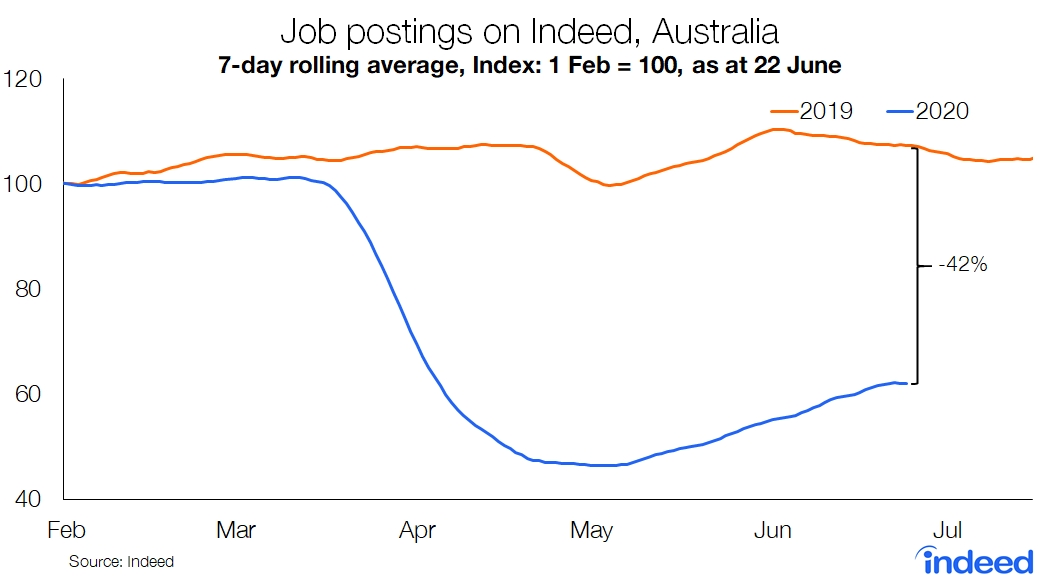It’s no secret the last few months have been rough for everybody thanks to coronavirus. If you were already out of work or were suddenly thrust into unemployment, you may have found it hard or even impossible to find work. There’s a good reason why.
The Australian Bureau of Statistics (ABS) released new figures on 25 June showing the number of job vacancies in Australia had fallen by 43 per cent in the May 2020 quarter — the worst it had ever recorded. The previous worst figure recorded was back in the 1990s recession at 27 per cent.
@ABSStats Australia job vacancies (May): -43.2% (record fall)#ausbiz #ausecon #commsec
— CommSec (@CommSec) June 25, 2020
Coming as a surprise to few, vacancy rates in the arts and recreation services industry were the worst, dropping by 95 per cent. It was followed by rental, hiring and real estate services at a 68 per cent drop and accommodation and food services at a 66 per cent fall.
Callam Pickering, Indeed’s APAC economist, said while the official unemployment rate looked bad at 7.1 per cent, the ABS and many economists widely consider it to be understated. Instead, it’s more likely to sit at 11.3 per cent and in conjunction with falling job openings, it equates to around 12 unemployed people per job vacancy.

Broken down into industry sectors, however, reveals a situation far worse for some.
There are around 980 unemployed people per job vacancy in the arts sector
Pickering explained to Lifehacker Australia that when you break down the number of unemployed people in a particular industry compared to job vacancies, it can muddy the story. For example, an accountant in a finance firm could change sectors if they found work in the healthcare sector in the same role.
Despite the rationale, the figure is still concerning, especially when it comes to the arts and recreation sector.
The arts and recreation sector was the worst hit with Pickering estimating 100 job vacancies Australia-wide with 88,000 suddenly unemployed.
“With employment in that sector falling by 88,000 people or 35 per cent due to COVID-19 — in addition to 10,000 people from the sector already unemployed before COVID-19 — we are looking at around 980 unemployed people per job vacancy,” Pickering said.
“That is by far the highest rate among industries.”
Jobs in accommodation and food services were slightly more abundant but it was still a dire look in.
“With employment in that sector falling by 293,000 or 31 per cent due to COVID-19 — in addition to around 65,000 people from the sector already unemployed before COVID-19 — there were around 72 unemployed people per job vacancy,” Pickering said.
Finding work should soon get easier with job vacancies improving
The good news is things are improving. Year-on-year figures still show how far we need to go before a full recovery but it suggests the worst is behind us for now.
“The situation for both sectors will have improved throughout June. As the economy opened up, we have seen restaurants reopen and more recently gyms as well,” Pickering said.
“So the number of vacancies has surely increased, providing a lifeline to workers across these sectors. But the figures highlight how dire the situation was at the height of the COVID-19 crisis where many workers had few opportunities to return to work and the few opportunities that did exist were highly sought after.”
Still, if you felt like it was near impossible to find work, the numbers are backing you up. While job openings are on the up, the next challenge will be finding the balance between keeping JobKeeper and Jobseeker payments while vacancies remain low. Pickering said it’s crucial the policy is upheld until things return to more stable levels.
“It is a simple maths equation: there simply aren’t enough jobs right now — even with the recent improvement — for everyone who wants a job to get one,” Pickering said.
“If vacancies remain below pre-crisis levels by September then pulling fiscal support would be misguided. It’ll damage and undermine the efforts made to protect the economy throughout the crisis.”

Leave a Reply
You must be logged in to post a comment.